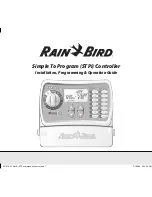
13.2.
Technical data Actuator controls
Features and functions
Refer to name plate
Permissible variation of mains voltage: ±10 %
Permissible variation of mains voltage: ±30 % (optional)
Permissible variation of mains frequency: ±5 %
Power supply
24 V DC +20 %/–15 %
Current consumption: Basic version approx. 250 mA, with options up to 500 mA
External power supply must have reinforced insulation against mains voltage in accordance with IEC
61010-1 and may only be supplied by a circuit limited to 150 VA in accordance with IEC 61010-1.
External supply of the electronics
(option)
Current consumption of the actuator controls depending on mains voltage:
For permissible variation of mains voltage of ±10 %:
●
100 to 120 V AC = max. 740 mA
●
208 to 240 V AC = max. 400 mA
●
380 to 500 V AC = max. 250 mA
●
515 to 690 V AC = max. 200 mA
For permissible variation of mains voltage of ±30 %:
●
100 to 120 V AC = max. 1,200 mA
●
208 to 240 V AC = max. 750 mA
●
380 to 500 V AC = max. 400 mA
●
515 to 690 V AC = max. 400 mA
Current consumption
Category III according to IEC 60364-4-443
Overvoltage category
The actuator controls are designed for the nominal motor power, refer to motor name plate
Rated power
Reversing contactors (mechanically and electrically interlocked) for AUMA power classes
A1/A2
Standard:
Switchgear
Reversing contactors (mechanically and electrically interlocked) for AUMA power class
A3
Options:
Thyristor unit for mains voltage up to 500 V AC (recommended for modulating actuators)
for AUMA power classes B1, B2 and B3
The reversing contactors are designed for a lifetime of 2 million starts. For applications requiring a high
number of starts, we recommend the use of thyristor units.
For the assignment of AUMA power classes, please refer to Electrical data on actuator
Via Modbus RTU interface
Control and feedback signals
●
2 free analogue inputs (0/4 – 20 mA), 4 free digital inputs
-
Signal transmission is made via fieldbus interface
●
Inputs OPEN, STOP, CLOSE, EMERGENCY, I/O interface, MODE (via opto-isolator thereof OPEN,
STOP, CLOSE, MODE with one common and EMERGENCY, I/O interface respectively without
common)
-
OPEN, STOP, CLOSE, EMERGENCY control inputs
-
I/O interface: Selection of control type (fieldbus interface or additional input signals)
-
MODE: Selection between open-close duty (OPEN, STOP, CLOSE) or modulating duty (0/4 –
20 mA position setpoint)
-
Additionally 1 analogue input (0/4 – 20 mA) for position setpoint
●
Inputs OPEN, STOP, CLOSE, EMERGENCY, I/O interface, MODE (via opto-isolator thereof OPEN,
STOP, CLOSE, MODE with one common and EMERGENCY, I/O interface respectively without
common)
-
OPEN, STOP, CLOSE, EMERGENCY control inputs
-
I/O interface: Selection of control type (fieldbus interface or additional input signals)
-
MODE: Selection between open-close duty (OPEN, STOP, CLOSE) or modulating duty (0/4 –
20 mA position setpoint)
-
Additionally 1 analogue input (0/4 – 20 mA) for setpoint position and 1 analogue input (0/4 – 20
mA) for actual process value
Fieldbus interface with additional
input signals (option)
24 V DC, current consumption: approx. 10 mA per input
Standard:
Control voltage/current consumption
for control inputs
48 V DC, current consumption: approx. 7 mA per input
60 V DC, current consumption: approx. 9 mA per input
100 – 125 V DC, current consumption : approx. 15 mA per input
100 – 120 V AC, current consumption : approx. 15 mA per input
Options:
All input signals must be supplied with the same potential.
Via Modbus RTU interface
Status signals
78
SQ 05.2 – SQ 14.2 / SQR 05.2 – SQR 14.2 Control unit - electromechanical
Technical data
AC 01.2 Intrusive Modbus RTU
















































